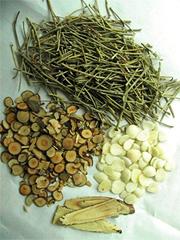About TCM Classic Herbal Formulae
- Present symptoms: chills, fever, headache, generalized aching, breath shortness and no sweating; thin and whitish coating on the tongue; floating and tense pulse;
- TCM disharmony pattern: external contraction of wind and coldness evils, that belongs to exterior and excess pattern;
- Therapeutic strategy: exterior syndrome is relieved by diaphoretic therapy (promotes perspiration) and the wind-cold invasion can be removed by pungent and warm herbs;
- Matched classical formula: Ephedra Decoction (ma huang tang) that consists of ephedra, cinnamon twig, bitter apricot kernel and liquorice root.
TCM treatment always based on disharmony patterns, selection and combination of the herbs should address to the disharmony patterns exactly. Since a TCM formula contains multiple interactive ingredients, it is customarily to rank the compositions in four groups when analyzing the role they play in the formulae.
- Monarch: the ingredient that exerts the major and leading effects in a formula. Generally, monarch drugs should constitute the largest proportion of a formula; a competent formula usually only contains one to two principal herbs so that the therapeutic effects can be focused.
- Minister: also known as the associate ingredient usually refers to two different functions. One is to support the monarch drug to exert major actions on the body, and the second is to improve and treat the accompanying symptoms or coexisting disharmony pattern. In comparison with the monarch drug, the minister drug usually has a weaker action.
- Assistant: the ingredients can play one of the following three roles in a formula. One is to reinforce the effects of the monarch or minister drug or to treat the less important coexisting patterns. The second role is to eliminate the toxicity of the monarch and minister ingredients, or modulate their harsh properties, and the third is to provide paradoxical assistance.
- Guide: these have two different functions. One is to force the actions of the formula on the target meridian or area of the body; and the second is to harmonize and integrate the effects on other drugs.
 Ephedra Decoction With reference to the Ephedra Decoction (ephedra, cinnamon twig, bitter apricot kernel and liquorice root) mentioned above, we can see how the ingredients interact with each other. In the formula, ephedra serves as the monarch herb for dispelling the pathogens on the exterior and relieving most of the symptoms. Cinnamon twig aids ephedra in inducing sweating and expelling the pathogens on the exterior, and thus has a minister role. Bitter apricot kernel helps the ephedra in enhancing the lungs so as to smooth the airway, a less important condition and thus is considered an assistant herb. Liquorice root modulates the harsh properties of ephedra and cinnamon twig and also acts in the assistant role. Since the first three herbs are all work similarly, it is not necessary to use a guiding herb in the formula.
Ephedra Decoction With reference to the Ephedra Decoction (ephedra, cinnamon twig, bitter apricot kernel and liquorice root) mentioned above, we can see how the ingredients interact with each other. In the formula, ephedra serves as the monarch herb for dispelling the pathogens on the exterior and relieving most of the symptoms. Cinnamon twig aids ephedra in inducing sweating and expelling the pathogens on the exterior, and thus has a minister role. Bitter apricot kernel helps the ephedra in enhancing the lungs so as to smooth the airway, a less important condition and thus is considered an assistant herb. Liquorice root modulates the harsh properties of ephedra and cinnamon twig and also acts in the assistant role. Since the first three herbs are all work similarly, it is not necessary to use a guiding herb in the formula.No matter how many herbs are selected in a herbal remedy, whether they play the role of monarch, minister, assistant or guide, herbal properties and efficacies should fit in with real health need of individual conditions. When physicians confirmed a formula, they will further modify the dose of each herb, decide the preparation method and even add extra herbal ingredients, due to the complexity of individual conditions. This part of skills needs extensive training and actual clinical experiences.
For centuries of practice, TCM scholars perfected various formulae for some typical disharmony patterns, and today, these classic formulae have become the basis for modern day usage. Many of them are so popular that they have been manufactured as patent remedies and are available in health stores.
Appropriate formula prescriptions based on accurate differential diagnosis can only be made by qualified TCM physicians. It is important to consult a qualified TCM physician to help you select the most appropriate formula.
- Exterior-relieving Formulae
- Purgative Formulae
- Digestive Formulae
- Harmonizing Formulae
- Heat-clearing Formulae
- Interior-warming Formulae
- Tonic Formulae
- Astringent Formulae
- Calming Formulae
- Orifice-opening Formulae
- Qi-regulating Formulae
- Blood-regulating Formulae
- Dampness-dispelling Formulae
- Phlegm-resolving Formulae
- Wind-eliminating Formulae
- Dryness-moistening Formulae
- #topic index
- #herbal prescription
- #Exterior-relieving formulae
- #Purgative formulae
- #Digestive formulae
- #Harmonizing formulae
- #Heat-clearing formulae
- #Interior-warming formulae
- #Tonic formulae
- #Astringent formulae
- #Calming formulae
- #Orifice-opening formulae
- #Qi-regulating formulae
- #Blood-regulating formulae
- #Dampness-dispelling formulae
- #Phlegm-resolving formulae
- #Wind-eliminating formulae
- #Dryness-moistening formulae


